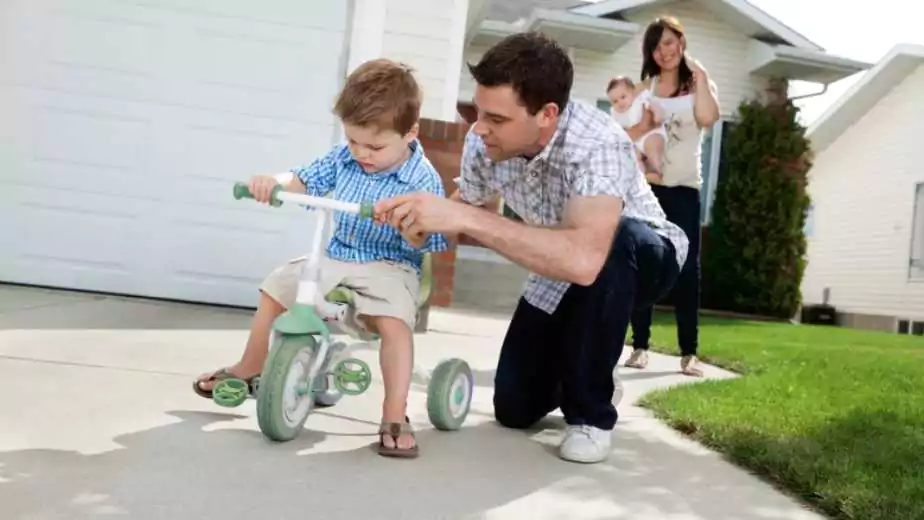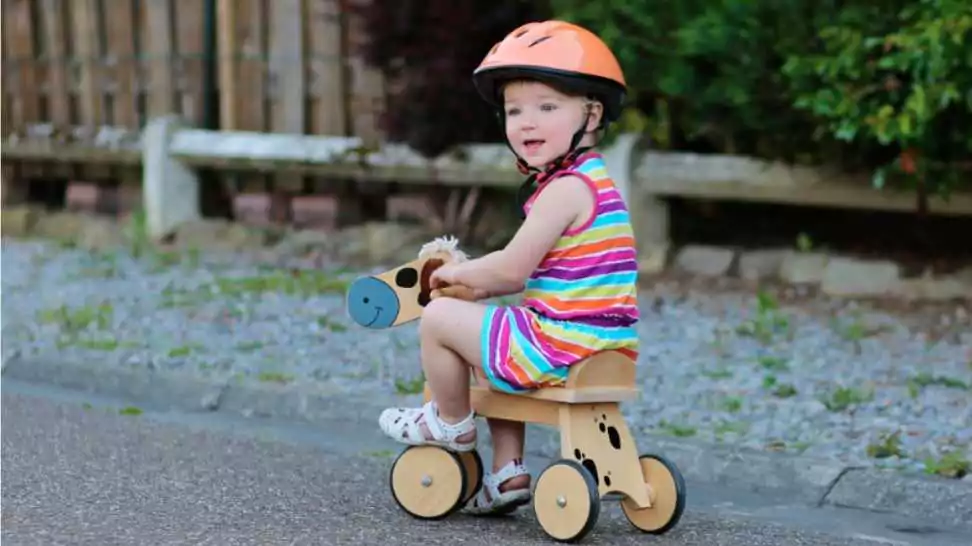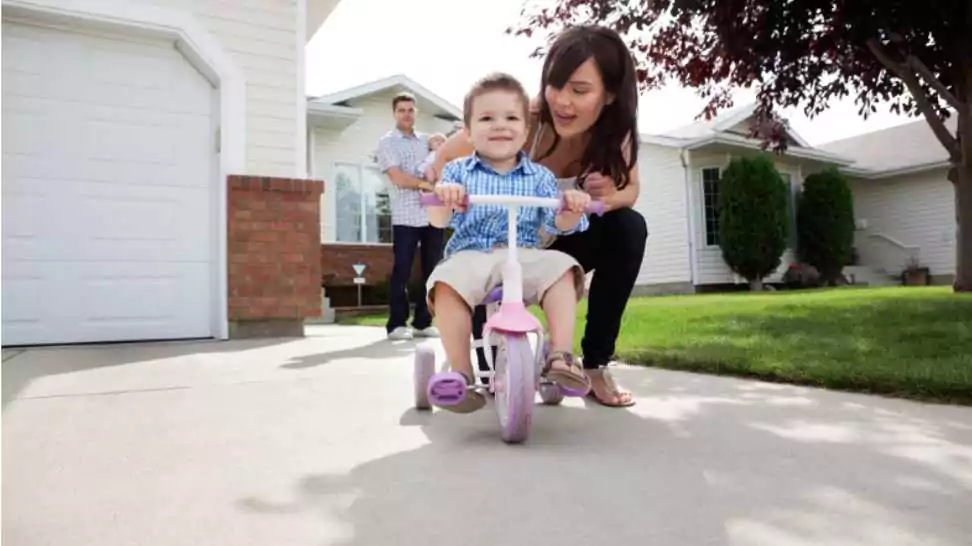How To Teach A Toddler To Ride A Tricycle?

Riding a tricycle is more than just play; it’s a developmental milestone for toddlers, enhancing motor skills, coordination, and outdoor enjoyment. My own experience teaching my child to ride a tricycle was a blend of challenges and joy – a testament to the growth and excitement this activity brings. “The thrill of the first ride is a seminal moment in a toddler’s life,” as famously noted, capturing the essence of these early adventures. This guide offers practical advice and insights on how to teach a toddler to ride a tricycle, covering appropriate age, tricycle selection, safety measures, and a step-by-step teaching approach to ensure a fulfilling experience for both you and your child.
1 Understanding the Right Age and Readiness
The Appropriate Age Range for Tricycle Riding

One of the most common questions parents have is, “When is the right age for my child to start riding a tricycle?” Generally, children are ready to begin tricycle training between the ages of 2 and 4. However, it’s crucial to understand that every child develops at their own pace. Age is a useful guideline, but it’s not the only factor to consider when determining if your toddler is ready to start pedalling.
Signs of Readiness in Toddlers
Recognizing the signs of readiness in your child is key. Here are some developmental milestones that indicate your toddler might be ready to take on a tricycle:
- Physical Strength and Balance: Can your child walk steadily and climb without assistance? Tricycle riding requires a certain degree of physical strength and balance. If your toddler is confidently walking and running, it might be time to introduce a tricycle.
- Coordination and Motor Skills: Observe if your child has started to develop fine motor skills, like holding and manipulating toys with ease. Riding a tricycle requires coordination of both hands and feet.
- Cognitive Skills: Does your toddler understand simple instructions? The ability to follow basic directions, such as ‘start’, ‘stop’, and ‘turn’, is essential for safe tricycle riding.
- Interest in Riding: Showing interest in bicycles or tricycles is a strong sign your toddler might be ready. Curiosity and enthusiasm towards riding are as important as physical readiness.
The Importance of Not Rushing the Process
Rushing a child into tricycle riding before they’re ready can be counterproductive. It’s essential to wait until your child shows both physical and cognitive signs of readiness. Introducing a tricycle too early can lead to frustration, fear, or even accidents, which might put them off cycling altogether.

2 Choosing the Right Tricycle
Selecting the perfect tricycle is a crucial step in ensuring a safe and enjoyable riding experience for your toddler. With the myriad of options available in the market, it can be overwhelming to make the right choice. Here are some essential factors to consider:
Factors to Consider
- Size: The size of the tricycle is paramount. Your child should be able to sit comfortably with their feet reaching the pedals and the ground. A tricycle that’s too big or too small can be challenging to manoeuvre and could compromise safety.
- Stability: Look for tricycles with a wide base and a low centre of gravity. These designs are less likely to tip over, making them safer for young riders. Stability is especially important for beginners who are still developing their balancing skills.
- Material: Tricycles are typically made from either metal or plastic. Metal tricycles are durable and long-lasting, while plastic models are lightweight and less prone to rust. Consider the environment where the tricycle will be used most often (indoors, outdoors, rough terrain) and choose a material that suits those conditions.
Safety Features to Look For
Safety should always be the top priority. Here are some safety features to look for:
- Sturdy Construction: A well-built tricycle will not only last longer but also provide a safer ride. Check for a solid frame and high-quality components.
- Low Center of Gravity: As mentioned earlier, a low centre of gravity prevents the tricycle from tipping over easily, providing a safer riding experience.
- Effective Brakes: Make sure the tricycle has an efficient braking system. Some models come with hand brakes, while others use pedal brakes. Choose one that your child can operate easily.
- Smooth Edges and Secure Fastenings: Avoid tricycles with sharp edges or loose parts. Smooth edges and secure fastenings reduce the risk of injury.
3 Preparing for the First Ride
Embarking on the first tricycle ride is an exciting milestone for both the child and the parent. Preparation is key to making this experience not only safe but also enjoyable and memorable. Here’s how to gear up for this big adventure.
Importance of Safety Gear

Safety gear is non-negotiable when it comes to riding a tricycle. Here are the essentials:
- Helmets: A well-fitted helmet is the most critical piece of safety gear. It should sit snugly on your child’s head and not wobble or slide. Ensure the helmet is certified for safety standards.
- Knee Pads and Elbow Pads: These provide additional protection, especially for beginners who might have a few tumbles. Pads can help prevent scrapes and bruises, making the learning process less intimidating.
- Bright Clothing or Reflective Gear: If your child is riding in an area where there are others around, bright clothing or reflective gear helps keep them visible and safe.
Choosing a Safe and Suitable Location for Practice
The right location can significantly impact the success of the first few rides:
Flat and Smooth Surface: Start in a flat, open area with a smooth surface, like a quiet sidewalk or a park path. Avoid hills and uneven terrain initially.
Low Traffic Area: A place with minimal traffic and distractions is ideal. It helps the child concentrate on learning without the stress of navigating around people or vehicles.
Enclosed or Semi-enclosed Space: If possible, choose an enclosed or semi-enclosed area where the child won’t venture too far. This containment offers a sense of security for both the child and the parent.
Tips on How to Make the Experience Fun and Stress-Free
- Positive Reinforcement: Encourage and praise your child, even for small achievements. Positive reinforcement goes a long way in boosting their confidence.
- Stay Patient and Calm: Learning to ride can be challenging, and there will be falls and frustrations. Your calm and patient demeanour reassures your child that it’s okay to make mistakes.
- Short Sessions: Keep the training sessions short, especially in the beginning. This prevents fatigue and keeps the experience enjoyable.
- Incorporate Games and Challenges: Make learning fun by incorporating simple games or challenges. For example, setting up a simple obstacle course or racing to a specific point can make the experience more engaging.
- Let Them Explore: Give your child some freedom to explore and learn at their own pace. Over-managing the process can take away from the joy of learning.
- Join In: If space allows, consider riding alongside your child with your bike or walking beside them. This shared experience can be incredibly bonding and encouraging for them.
4 Teaching Techniques

Teaching a toddler to ride a tricycle is a process that requires patience, encouragement, and the right techniques. Here’s a step-by-step guide to help your child master the art of tricycle riding.
Getting Acquainted with the Tricycle
- Familiarisation: Start by letting your child get familiar with the tricycle. Encourage them to sit on it, touch it, and explore its parts. Explain its functions in simple terms.
- Sitting Comfortably: Ensure your child is sitting comfortably on the tricycle. Their feet should reach the pedals, and their hands should comfortably grip the handlebars.
- Safety Checks: Show them how to check if the tricycle is safe to ride. This includes checking the wheels and ensuring everything is securely fastened.
Learning to Pedal
- Leg Movement: Initially, your child might not understand how to move their legs to pedal. Gently guide their feet with your hands to demonstrate the pedalling motion.
- Encouraging Self-Propulsion: Once they get the hang of the motion, encourage them to try it on their own. Start on a slight downhill slope to make it easier for them to begin moving without much effort.
- Gradual Progression: As they become more comfortable, encourage them to pedal on flatter surfaces. Ensure they understand how to stop by using the brakes or their feet.
Steering and Navigating
- Simple Steering Exercises: Begin with simple steering exercises. Place objects for them to navigate around or create a straightforward course they can follow.
- Understanding Control: Teach them how turning the handlebars changes the tricycle’s direction. Practice in a safe, open area where minor mistakes won’t lead to injuries.
- Building Confidence: As their confidence grows, introduce more complex steering challenges, like making tighter turns or navigating through narrower paths.
How to Encourage and Praise Effectively?
- Specific Praise: Instead of general praise, be specific about what they’re doing well, such as “Great job pedalling!” or “You steered so well around that corner!”
- Celebrate Milestones: Celebrate small milestones, like their first successful pedal or navigating a turn, to motivate them further.
- Stay Positive: Maintain a positive tone, even when correcting them. Focus on the effort they’re making rather than the outcome.
Dealing with Common Challenges and Fears
- Fear of Falling: Reassure your child that it’s okay to fall and that it’s part of learning. Always use safety gear to minimise the fear of getting hurt.
- Frustration with Pedalling: If your child gets frustrated, take a break and try again later. Sometimes, a short break can make a big difference.
- Overcoming Obstacles: Encourage them to keep trying when they face obstacles. Assist them initially, but gradually let them handle challenges independently to build resilience.
- Consistent Practice: Consistency is key. Regular, short practice sessions are more effective than occasional, long ones.

5 Safety First
While tricycle riding is an exciting and beneficial activity for toddlers, ensuring their safety is paramount. This section covers essential safety tips, teaching road safety basics at an early age, and handling falls to encourage resilience.
Essential Safety Tips
- Constant Supervision: Never leave your child unsupervised while they’re riding. Close supervision helps prevent accidents and allows you to guide and encourage them.
- Environment Safety: Choose a safe riding environment away from traffic, water bodies, and steep slopes. Ensure the area is free from hazards like sharp objects, large cracks, or uneven surfaces.
- Regular Tricycle Maintenance: Regularly check the tricycle for any loose parts, tire inflation, and overall stability to ensure it’s always safe to ride.
- Weather Considerations: Avoid riding in extreme weather conditions. Ensure your child is dressed appropriately for the weather when they’re riding outside.
Teaching Road Safety Basics at an Early Age
- Understanding Boundaries: Teach your child to stay within safe boundaries while riding. This can be as simple as defining certain areas in a park where they can ride.
- Basic Traffic Rules: Introduce basic concepts like ‘stop’, ‘look’, and ‘listen’ before crossing an area, even if it’s just the driveway or a quiet street.
- Use of Safety Gear: Instil the habit of always wearing a helmet and other safety gear every time they ride, reinforcing the importance of protection.
- Role-Playing Games: Use role-playing games to teach road safety. Pretend to be pedestrians, drivers, or traffic signals to make learning about road safety engaging and memorable.
Handling Falls and Encouraging Resilience
- React Calmly to Falls: If your child falls, remain calm. A calm reaction reassures them and helps them manage their distress.
- Teaching Safe Falling Techniques: Teach them to try to fall sideways rather than forwards or backwards, and to use their arms to protect their head.
- Encouragement After a Fall: Encourage them to get back on the tricycle after they fall, once you’ve ensured they’re not seriously hurt. This builds resilience and confidence.
- Discussing the Experience: Talk about the fall with your child. Discussing what happened can help them learn from the experience and feel more prepared to handle it in the future.
6 Wrapping Up
In this guide, we’ve seen how teaching toddlers to ride a tricycle goes beyond fun, nurturing developmental milestones and joyful learning. This activity not only enhances physical abilities but also boosts cognitive and emotional growth.
Remember, patience and consistency are crucial as each child progresses at their own pace. Our role is to support and provide a safe space for exploration and growth, understanding that challenges are part of the journey, and building resilience and confidence.
Concluding with Friedrich Nietzsche’s words, “In every real man a child is hidden that wants to play,” we’re reminded of the pure joy and wonder in childhood adventures like tricycle riding.
Community Q&A
About This Article
This article has been viewed 108 times.




Usually I do not read article on blogs however I would like to say that this writeup very compelled me to take a look at and do it Your writing style has been amazed me Thank you very nice article